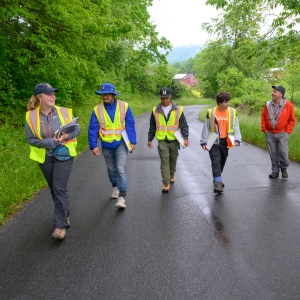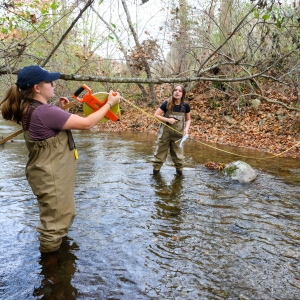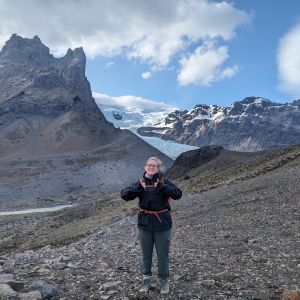
Earth and Environmental Geoscience Department

Earth and Environmental Geoscience offers a highly relevant, integrative, scientific avenue of study for managing our interactions with the environment, providing adequate resources, ensuring the safety of the built environment in the face of natural hazards, and solving the complex history of earth and its continuing evolution. We make extensive use of the extraordinary geology of the Appalachians and other locales around the globe, including Iceland, the Colorado Plateau, Hawai’i, Utah, Belize, New Zealand, and Greece. We offer many research opportunities using scientific computing, field programs, laboratory analyses, and GIS mapping.

W&L Earth and Environmental Geoscience Professor Publishes Peer-Reviewed Article
Margaret Anne Hinkle collaborated with additional authors to produce an article focused on manganese exposure in spring and well water in the Shenandoah Valley.

After 25 years, W&L faculty member Chris Connors teaches his swan song Spring Term class, Field Methods and Regional Geology of the Appalachians.

At the 2025 undergraduate Commencement, Barbara Jenkins ’92L, Kate Jenkins Howard ’99 and Kylie Therrien ’25 became the first female triple generation legacy at Washington and Lee University.

W&L’s Katalyn Denby ’26 Awarded Goldwater Scholarship
Denby’s funded research will focus on erosional river processes.

Howard Capito ’68 established the Christopher D. Connors Endowment for Earth and Environmental Geoscience to honor the “living legend” and support student internships in geology and related fields.

This fall, W&L students learned environmental field methods at a six-acre site in Rockbridge County set aside for experiential learning.

Greer’s talk, “Coral Reefs Past, Present and Future and Our Human Footprint,” will be held Jan. 15 in Science Addition 214.

Twelve W&L Students Awarded Gilman Scholarships to Study Abroad
The Gilman Scholarship Program offers awards of up to $5,000 to U.S. undergraduate students who are Pell Grant recipients.

Marvelli enjoys building a community on campus as an RA and through her academic work.

Margaret Anne Hinkle Awarded a Collaborative Grant from the National Science Foundation
Hinkle and fellow scientists from the University of Pittsburgh will share the $550,000 award to examine the potential of adapting acid mine drainage remediation systems to produce critical minerals in economically viable concentrations.

By enlisting guidance from the W&L science community, Emma Marvelli ’27 combined a Spring Term abroad class with summer research to better understand Virginia meta-basalts and their potential for combating climate change.

In September, Maloy will move to Germany for a Fulbright English Teaching Assistantship.

W&L Earth and Environmental Geoscience Professor Publishes Peer-Reviewed Article
Margaret Anne Hinkle collaborated with additional authors to produce an article focused on manganese exposure in spring and well water in the Shenandoah Valley.

After 25 years, W&L faculty member Chris Connors teaches his swan song Spring Term class, Field Methods and Regional Geology of the Appalachians.

At the 2025 undergraduate Commencement, Barbara Jenkins ’92L, Kate Jenkins Howard ’99 and Kylie Therrien ’25 became the first female triple generation legacy at Washington and Lee University.

W&L’s Katalyn Denby ’26 Awarded Goldwater Scholarship
Denby’s funded research will focus on erosional river processes.

Howard Capito ’68 established the Christopher D. Connors Endowment for Earth and Environmental Geoscience to honor the “living legend” and support student internships in geology and related fields.

This fall, W&L students learned environmental field methods at a six-acre site in Rockbridge County set aside for experiential learning.

Greer’s talk, “Coral Reefs Past, Present and Future and Our Human Footprint,” will be held Jan. 15 in Science Addition 214.

Twelve W&L Students Awarded Gilman Scholarships to Study Abroad
The Gilman Scholarship Program offers awards of up to $5,000 to U.S. undergraduate students who are Pell Grant recipients.

Marvelli enjoys building a community on campus as an RA and through her academic work.

Margaret Anne Hinkle Awarded a Collaborative Grant from the National Science Foundation
Hinkle and fellow scientists from the University of Pittsburgh will share the $550,000 award to examine the potential of adapting acid mine drainage remediation systems to produce critical minerals in economically viable concentrations.

By enlisting guidance from the W&L science community, Emma Marvelli ’27 combined a Spring Term abroad class with summer research to better understand Virginia meta-basalts and their potential for combating climate change.

In September, Maloy will move to Germany for a Fulbright English Teaching Assistantship.

W&L Earth and Environmental Geoscience Professor Publishes Peer-Reviewed Article
Margaret Anne Hinkle collaborated with additional authors to produce an article focused on manganese exposure in spring and well water in the Shenandoah Valley.

After 25 years, W&L faculty member Chris Connors teaches his swan song Spring Term class, Field Methods and Regional Geology of the Appalachians.
Department Info
- P: 540-458-8800
-
Earth and Environmental Geoscience Department
204 West Washington Street
Washington and Lee University
Lexington, Virginia 24450